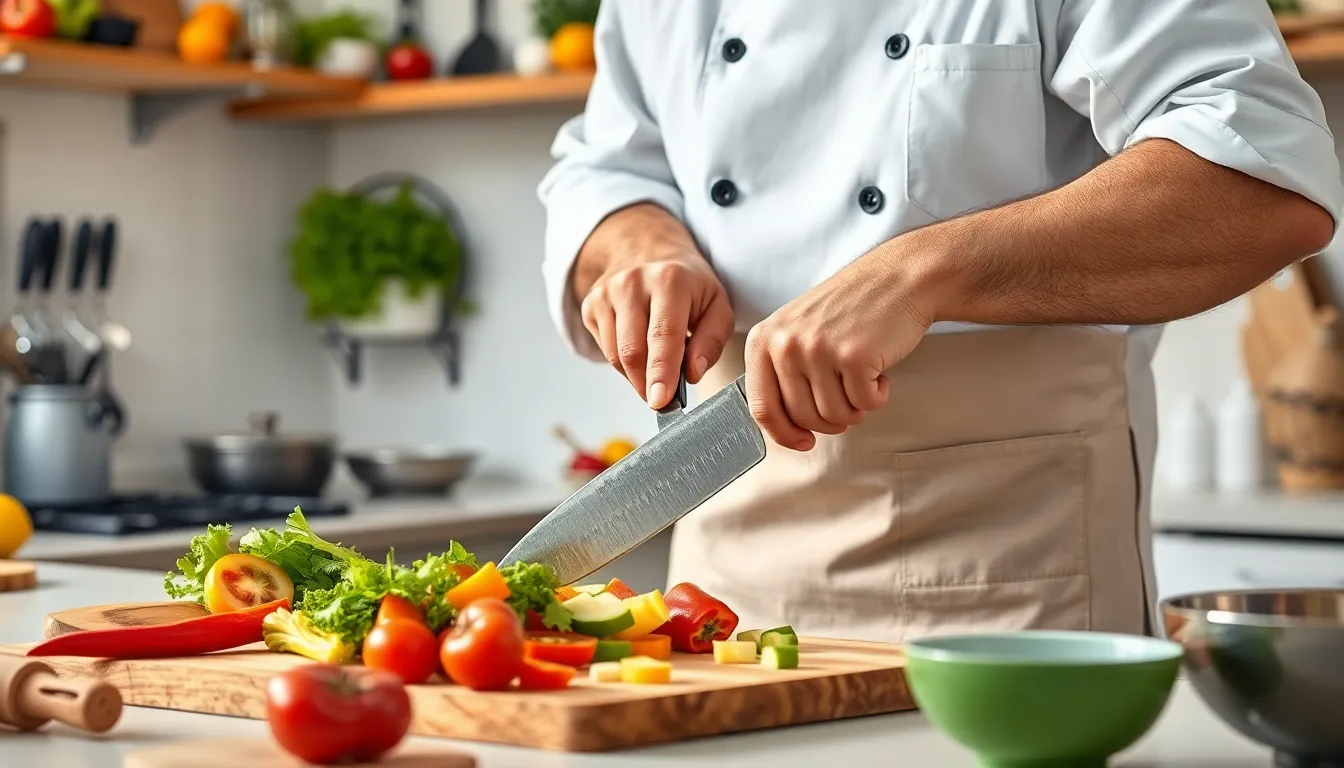Table of Contents
ToggleCooking isn’t just about throwing ingredients together and hoping for the best. It’s an art form that transforms the mundane into the magnificent. Whether it’s whipping up a gourmet meal or mastering the perfect scrambled eggs, the kitchen becomes a canvas where creativity can flourish.
The Art of Cooking: An Overview
Cooking transcends merely combining ingredients; it embodies creativity and passion. Expression through food offers personal satisfaction as well as delighting others. The kitchen serves as a canvas where flavors, textures, and aromas combine to create memorable dishes. Techniques often vary, yet the fundamentals remain essential for success.
Ingredient selection significantly impacts the final product. Fresh produce, high-quality proteins, and aromatic herbs enhance flavors and nutritional value. Mastering basic cooking techniques, such as sautéing, roasting, and braising, opens the door to culinary experimentation. Knowledge of knife skills allows for precision in preparation, lending to a professional touch in home kitchens.
The cultural aspect of cooking enriches the experience. Traditional recipes passed down through generations foster connection to heritage. Regional specialties reflect diverse ingredients and methods influenced by geography. Implementing these customs elevates meals beyond flavors, imbuing them with history and significance.
Presentation also plays a vital role in the culinary arts. Visual appeal can enhance appreciation for a dish, inviting diners to savor both sight and flavor. Techniques for plating, such as garnishing and arranging, transform a simple meal into an extraordinary experience. Creativity extends to this aspect, as colors and shapes can evoke emotions and stimulate appetite.
Cooking serves as a continuous journey of learning. He or she learns to adapt recipes based on preferences, diets, or seasonal availability. Experimentation encourages innovative dishes, fostering growth as a chef. Embracing challenges cultivates resilience while building confidence in one’s cooking abilities. Through exploring different cuisines and techniques, one finds endless inspiration in the art of cooking.
Essential Cooking Techniques

Mastering essential cooking techniques enhances a cook’s skills and confidence. Techniques such as knife skills and various cooking methods form the foundation of culinary artistry.
Knife Skills
Knife skills are fundamental for efficiency and safety. Precision in chopping vegetables, herbs, and proteins not only saves time but also improves presentation. The process involves using the right knife for each task, such as a chef’s knife for general cutting and paring knives for intricate work. Regular practice helps develop consistency and sharpness in cuts. Holding knives properly prevents injury and improves control. As expertise grows, cooks can experiment with different cuts, such as julienne or chiffonade, enriching dish textures and appearances.
Cooking Methods
Cooking methods vary widely, influencing flavor and texture. Techniques like sautéing, boiling, and roasting transform ingredients into delicious meals. Sautéing involves cooking food quickly in a small amount of oil, enhancing flavors while retaining nutrients. Boiling, on the other hand, softens ingredients and is perfect for pastas and soups. Roasting adds depth by browning food, creating appealing textures. Exploring methods such as steaming and grilling expands possibilities for healthy meals. Each method offers distinct advantages, encouraging culinary creativity and diversity in recipes.
Ingredients and Their Importance
Ingredients form the foundation of any cooking endeavor, significantly impacting flavor, texture, and nutritional value.
Fresh vs. Processed Ingredients
Fresh ingredients offer superior taste and nutrients. Fruits and vegetables picked at their peak freshness contain higher vitamins and minerals. Processed ingredients tend to lack these nutritional benefits due to preservation methods. While they provide convenience, they often incorporate additives that could detract from a dish’s natural flavors. Cooks who prefer using fresh ingredients can experiment with seasonal produce, enhancing creativity. Additionally, opting for fresh ingredients promotes sustainability, supporting local farmers and reducing food mileage.
Herbs and Spices
Herbs and spices elevate dishes, adding depth and complexity. Fresh herbs like basil, cilantro, and parsley introduce vibrant flavors that dried counterparts may lack. Spices such as cumin, paprika, and turmeric bring warmth and character, transforming simple recipes into culinary masterpieces. Properly balancing herbs and spices is essential for harmony in flavor profiles. Cooking techniques like toasting spices can intensify their aromas, enhancing the overall dish. Incorporating various herbs and spices fosters exploration of diverse cuisines, allowing cooks to personalize their culinary creations.
The Role of Presentation in Cooking
Presentation significantly impacts the overall dining experience. A beautifully arranged plate captivates attention and stimulates appetite.
Plating Techniques
Effective plating techniques transform simple food into art. Using layers showcases texture, while height adds drama. Color contrast enhances a dish’s appeal, drawing the eye toward vibrant vegetables or garnishes. Round plates create an inviting canvas, allowing for creative designs. Forks and spoons placed strategically can guide diners’ experiences. Additionally, negative space—areas without food—prevents clutter, making the meal look more refined.
Visual Appeal
Visual appeal enhances enjoyment and satisfaction with a dish. Bright colors stimulate the senses, making ingredients pop and inviting curiosity. Shapes also play a role; varied forms create interest and make meals memorable. Proper arrangement of food helps highlight key components, ensuring important flavors catch attention. Texture variety contributes to visual excitement, with crispy elements contrasting soft ones. Ultimately, well-presented food showcases a cook’s skill, turning any meal into a delightful experience.
Exploring Culinary Cultures
Culinary cultures provide insight into the history, traditions, and flavors of different regions. Each culture presents unique ingredients and techniques that enrich the global culinary landscape.
Regional Variations
Regional variations in cuisine highlight the diversity found in cooking practices worldwide. Every culture’s geography influences ingredient availability, leading to distinctive flavor profiles. For example, Mediterranean dishes often feature olive oil, while Asian cuisines frequently incorporate rice and soy. Climate also affects cooking methods, with tropical regions favoring fresh fruits and seafood. Additionally, cultural celebrations shape local dishes, creating festive meals that honor traditions. Recipes passed down through generations reflect community values and regional pride, showcasing local ingredients in seasonal dishes. Understanding these variations fosters appreciation for global culinary traditions.
Traditional Dishes
Traditional dishes serve as valuable representations of cultural heritage. Specific recipes often connect families and communities to their roots. For instance, Italian pasta dishes showcase regional ingredients like semolina and egg, while Indian curries emphasize spices and aromatics. These dishes tell stories of cultural significance and local practices. Cooking methods, such as slow braising or steaming, enhance flavors while preserving techniques unique to each region. Each traditional dish embodies creativity and adaptability, allowing modern cooks to reinterpret classic recipes. Exploring these foods invites a deeper connection to cultural identity through the shared joy of cooking and eating.
Cooking is a journey that blends creativity and tradition. It transforms everyday ingredients into extraordinary meals that nourish both body and soul. Each dish tells a story and connects individuals to their heritage while inviting exploration of diverse cuisines.
As cooks refine their skills and experiment with flavors they discover the joy of personal expression in the kitchen. The art of cooking encourages a deeper appreciation for ingredients and the beauty of presentation.
Ultimately it’s about more than just food; it’s about creating memories and sharing experiences. Embracing this culinary adventure enriches lives and fosters connections that go beyond the plate.







